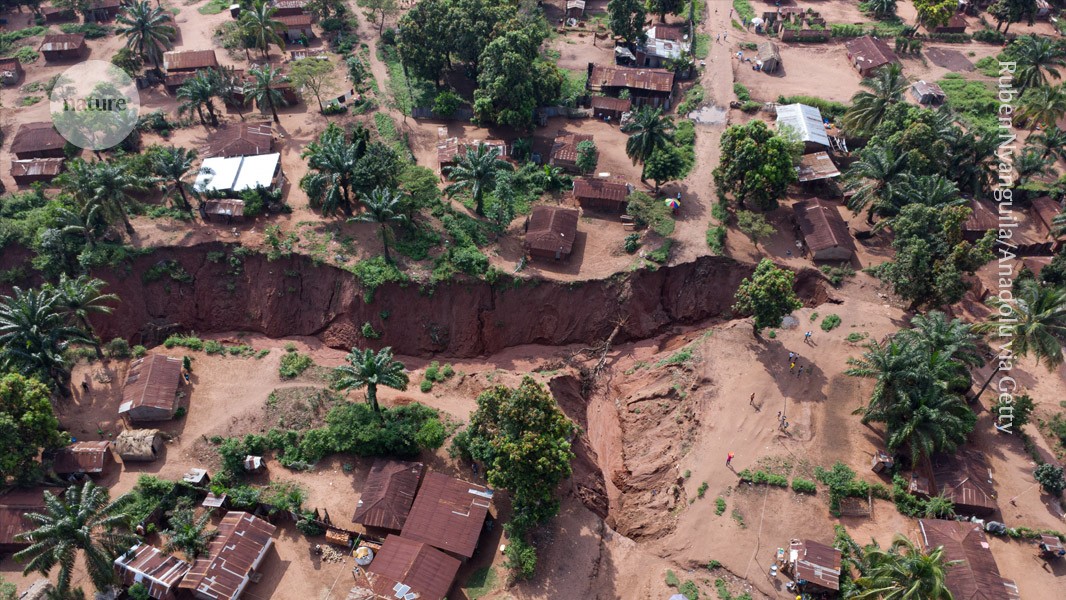Deep gashes are tearing through cities, swallowing houses and displacing vast numbers of people

Hundreds of thousands of people are at risk of displacement from expanding ‘gullies’ in cities across Africa
Gigantic trenches known as gullies are opening up in cities in Africa, swallowing up homes and businesses, sometimes in an instant, a study has found1.
About 118,600 people, on average, in the Democratic Republic of the Congo (DRC) alone were displaced between 2004 and 2023, according to researchers reporting their findings in Nature.
Without urgent action, researchers estimate that hundreds of thousands of people across Africa are likely to be displaced within the next 10 years, including more than one-quarter of the 770,000 or so people in the DRC living in the expected expansion zone of these gullies.
“It’s an underestimated and severely under-researched hazard,” says study co-author Matthias Vanmaercke, a geographer at the Catholic University of Leuven (KU Leuven) in Belgium. It is caused by “a combination of natural and human factors”, he says, but this is “not at all unavoidable”.
Expanding gullies
Gullies are expanding across cities that are built on sandy soils and lack adequate drainage. When there are heavy rains, water accumulates on roads and rooftops. When the drainage systems are inadequate, the water finds its way into unprotected ground, carving deep holes that can stretch for hundreds of metres. Over time, the gullies swallow houses and other infrastructure, and sometimes even result in deaths.
Vanmaercke and his colleagues used satellite images taken between 2021 and 2023 to identify 2,922 urban gullies in 26 of 47 cities, covering a cumulative distance of nearly 740 kilometres. The team cross-checked these images with historical aerial photographs stored at the Royal Museum for Central Africa in Belgium and found that only 46 of the gullies were present in the 1950s. This “gave the first clear indication that this is indeed attributable to the ongoing urbanization”, Vanmaercke says.
In 99% of cases, the gullies had expanded by at least 10 square metres between 2004 and 2023. The average gully was 253 metres long and 31 metres across at its widest point, and nearly all of them were linked to the road network. “The water cannot infiltrate, and it concentrates along these roads which basically become big canals that turn into rivers,” says Vanmaercke.
The researchers then combined data on population density with the gully maps. This enabled them to estimate that an average of 118,600 people were displaced because of gullies over the period — with displacement rates more than doubling after 2020.
Guy Ilombe Mawe, a geomorphologist at the Official University of Bukavu in the DRC and a co-author of the paper says that the widening of gullies can be catastrophic and even fatal, and that families living near gullies often have no safe alternatives.
In November 2019, the researchers visited Kinshasa, the DRC’s capital and one of the most affected cities, with 868 urban gullies stretching over a total of 221 kilometres. There they met a mother whose home stood near a gully edge. Two days later, several of her children were killed while sheltering at a relative’s house, when an expanding gully collapsed overnight. At least 40 people in Kinshasa died that night.
Enjoying our latest content?
Login or create an account to continue
- Access the most recent journalism from Nature's award-winning team
- Explore the latest features & opinion covering groundbreaking research
or
Sign in or create an account Continue with Google
Continue with Google
doi: https://doi.org/10.1038/d41586-025-02745-x
Read the associated News & Views article ‘Gully formation in cities is displacing tens of thousands of people’.
This story originally appeared on: Nature - Author:Miryam Naddaf

















